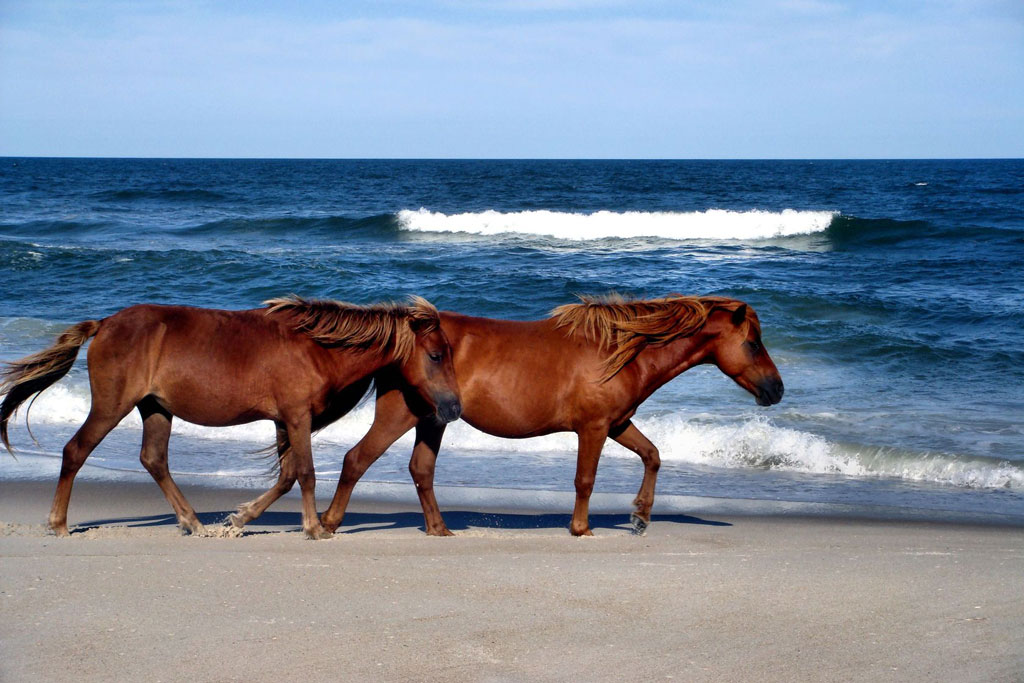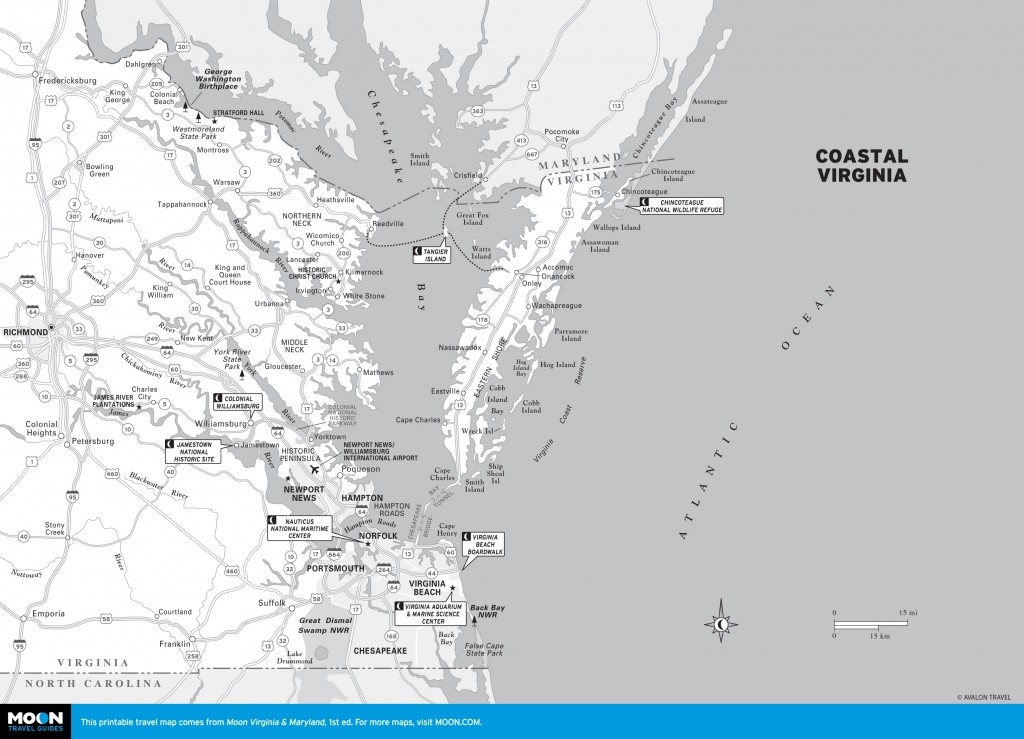
Two of Assateague’s wild ponies walk along the shoreline. Photo © Paige Engel/123rf.
Assateague Island sits opposite Ocean City across the Ocean City Inlet. It is considered part of both Virginia and Maryland. The inlet didn’t always exist. It was formed during the Chesapeake-Potomac Hurricane in 1933, which created a nice inlet at the south end of Ocean City, and the Army Corps of Engineers decided to make it permanent.In its southern reaches, Assateague Island borders Chincoteague Island. Both Assateague and Chincoteague are known for their resident herds of wild ponies and the famous Wild Pony Swim that takes place each year in late July, when the herd is taken for a swim from Assateague Island across the channel to Chincoteague Island.
There are two entrances to the Assateague Island National Seashore. One is eight miles south of Ocean City at the end of Route 611. From Ocean City, cross the bridge on Route 50 heading west. Turn left at the third traffic light onto Route 611. Follow the brown signs to the park. The second is at the southern end of the island at the end of Route 175, two miles from Chincoteague, Virginia. Visitors to Assateague Island can stay in Chincoteague or Ocean City since there are no hotel accommodations on the island.
Assateague Island National Seashore (year-round in Maryland, 24 hours, $3) was established in 1962. It is managed by three park agencies: the National Park Service, U.S Fish & Wildlife Service, and the Department of Natural Resources. The island includes a beautiful 37-mile beach, dunes, wetlands, and marsh. The island is protected as a natural environment, and many opportunities exist for wildlife viewing. Assateague Island is a stopover for migrating shorebirds and provides important areas for feeding and resting. More than 320 bird species can be viewed here during the year, including the piping plovers, great egrets, and northern harriers.
Assateague Island is also known for its wild ponies. It is widely believed that the ponies originally came to the island years ago when a Spanish cargo ship loaded with horses sank off the coast and the ponies swam to shore. In 1997, a Spanish shipwreck was discovered off the coast, which supports this theory.
Other mammals in Assateague include rodents as small as the meadow jumping mouse, red fox, river otter, and deer. Several species of whales feed off the island’s shore, along with bottlenose dolphin.
There are two entrances to the national seashore. One is eight miles south of Ocean City at the end of Route 611. The second is at the southern end of the island at the end of Route 175, two miles from Chincoteague, Virginia. Visitors to Assateague Island can stay in Chincoteague or Ocean City since there are no hotel accommodations on the island.
Park hours and fees are different in Virginia and Maryland and also vary by month in Virginia. Consult Assateague Island for specific information for the time of year and location you wish to visit.
The Assateague Island Visitor Center (Maryland District of Assateague Island, on the southern side of Route 611, 410/641-1441, year-round daily 9am-5pm) offers a film on the wild ponies, brochures, aquariums, a touch tank, maps, and other exhibits.
The brilliant red-and-white-striped Assateague Island Lighthouse (0.25 mile from Chincoteague Island and accessible from Chincoteague by car in approximately five minutes and from Maryland in an hour, 757/336-3696, June-Sept. daily 9am-3pm, Apr.-May and Oct.-Nov. Fri.-Sun. 9am-3pm, $5) is on the Virginia side of Assateague Island. There is a trail that connects Chincoteague with Assateague Island that can be walked or accessed by bicycle. The original lighthouse was built in 1833 but was replaced by a taller, more powerful lighthouse in 1867. The lighthouse is still in operation today and features twin rotating lights that sit 154 feet above sea level. The U.S. Coast Guard maintains the light as a working navigational aid, but the Chincoteague National Wildlife Refuge is responsible for the lighthouse preservation efforts. The top of the lighthouse can be visited by the public.
Due in part to its relative isolation, Assateague Island has one of the nicest beaches on the East Coast. Visitors can enjoy the area by kayaking, beach walking, swimming, fishing, biking, and bird-watching.
The Maryland Coastal Bays Program operates a kayak ($15 per hour), canoe ($10 per hour), paddleboard ($25 per hour), and bike rental ($6 per hour) stand on Assateague Island National Seashore (13002 Bayside Dr., Berlin, 410/726-3217, mid-Apr.-Memorial Day weekends 10am-4pm, Memorial Day-Labor Day daily 9am-6pm, Labor Day-mid-Oct. weekends only 10am-4pm). To find the stand, take the second right after the park tollbooth. A 3.5-mile paved bike path leads from Route 611 through the parks.
Camping is allowed on the Maryland side of the National Seashore through the National Park Service (410/641-2120, $20). Oceanside and bayside campsites are available all year. Sites do not have hookups but can accommodate tents, trailers, and RVs. There are also horse sites ($30) and group tent sites ($40). Cold showers and chemical toilets are available on-site. Camping is also permitted in Assateague State Park (7307 Stephen Decatur Hwy., 410/641-2918, late Apr.-Oct., $30), also on the Maryland side of the island. There are 300 campsites here. Each site has a picnic table, fire ring, room for one car, and access to a bathhouse with warm showers. Backpackers and kayakers can also take advantage of backcountry camping. Camping information can be found at www.assateagueisland.com.

Coastal Virginia
Excerpted from the First Edition of Moon Virginia & Maryland.